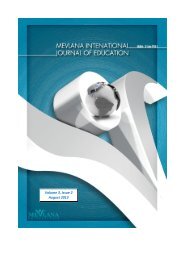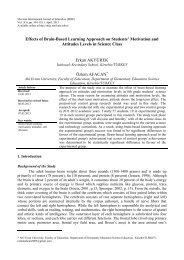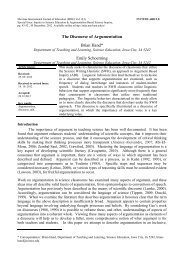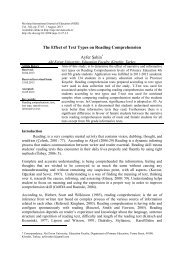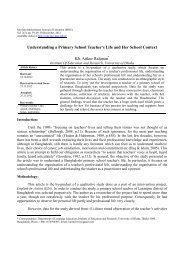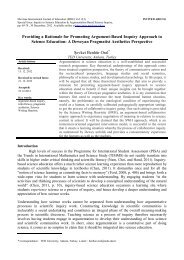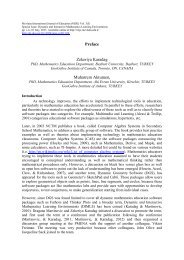Overview of the Visual Arts Curriculum, and Its Relationship with ...
Overview of the Visual Arts Curriculum, and Its Relationship with ...
Overview of the Visual Arts Curriculum, and Its Relationship with ...
You also want an ePaper? Increase the reach of your titles
YUMPU automatically turns print PDFs into web optimized ePapers that Google loves.
Mevlana International Journal <strong>of</strong> Education (MIJE)<br />
Vol. 3(1), pp. 143-151, 1 April, 2013<br />
Available online at http://mije.mevlana.edu.tr/<br />
<strong>Overview</strong> <strong>of</strong> <strong>the</strong> <strong>Visual</strong> <strong>Arts</strong> <strong>Curriculum</strong>, <strong>and</strong> <strong>Its</strong> <strong>Relationship</strong> <strong>with</strong> Evaluation <strong>and</strong><br />
Instruction.<br />
Article history<br />
Received:<br />
18.02.2013<br />
Received in revised form:<br />
28.03.2013<br />
Accepted:<br />
01.04.2013<br />
Key words:<br />
The <strong>Curriculum</strong>; <strong>the</strong> <strong>Visual</strong><br />
<strong>Arts</strong> <strong>Curriculum</strong>; Evaluation;<br />
Instruction; <strong>Relationship</strong><br />
Between <strong>Curriculum</strong>,<br />
Instruction <strong>and</strong> Evaluation<br />
IMONIKEBE Manasseh Emamoke *<br />
University <strong>of</strong> Benin, Benin City, Nigeria.<br />
Evaluation <strong>and</strong> Instruction play very important roles in curriculum<br />
implementation. As a result, <strong>the</strong> two concepts are <strong>of</strong>ten enshrined in <strong>the</strong><br />
curriculum document. This article <strong>the</strong>refore examined <strong>the</strong> <strong>Visual</strong> <strong>Arts</strong><br />
curriculum <strong>and</strong> its relationship <strong>with</strong> evaluation <strong>and</strong> instruction.<br />
Fur<strong>the</strong>rmore, <strong>the</strong> roles <strong>of</strong> Evaluation <strong>and</strong> Instruction in curriculum<br />
planning <strong>and</strong> implementation were investigated. The article was<br />
approached as follows: <strong>Overview</strong> <strong>of</strong> curriculum; <strong>Overview</strong> <strong>of</strong> Art<br />
Education <strong>and</strong> <strong>the</strong> <strong>Visual</strong> <strong>Arts</strong> curriculum; Evaluation; Instruction; <strong>and</strong><br />
<strong>Relationship</strong> between curriculum, instruction <strong>and</strong> evaluation. It was<br />
revealed that curriculum, evaluation <strong>and</strong> instruction are inextricably<br />
linked. That, while <strong>the</strong> <strong>Visual</strong> <strong>Arts</strong> curriculum is planned by <strong>the</strong><br />
curricularist, instruction is what <strong>the</strong> <strong>Visual</strong> <strong>Arts</strong> teacher plans to realize<br />
<strong>the</strong> curriculum; that, evaluation is an enterprise carried out by <strong>the</strong> teacher<br />
at <strong>the</strong> implementation level. The findings were discussed as <strong>the</strong>y apply to<br />
<strong>the</strong> Art Education Programme.<br />
Introduction<br />
Evaluation <strong>and</strong> instruction are two critical factors <strong>of</strong>ten included in <strong>the</strong> curriculum<br />
document. The two factors have been found to play a key role in curriculum implementation.<br />
The purpose <strong>of</strong> this article <strong>the</strong>refore is to examine <strong>the</strong> <strong>Visual</strong> <strong>Arts</strong> curriculum <strong>and</strong> its<br />
relationship <strong>with</strong> evaluation <strong>and</strong> instruction. This attempt is fur<strong>the</strong>r intended to clarify <strong>the</strong><br />
roles <strong>of</strong> evaluation <strong>and</strong> instruction in relation to <strong>the</strong> <strong>Visual</strong> <strong>Arts</strong> curriculum. It is expected that<br />
this effort will challenge <strong>the</strong> Art Educator to take <strong>the</strong> afore-mentioned two concepts seriously<br />
in his process <strong>of</strong> implementing <strong>the</strong> curriculum. The article has been approached in <strong>the</strong><br />
following order:<br />
(1) <strong>Overview</strong> <strong>of</strong> curriculum generally.<br />
(2) <strong>Overview</strong> <strong>of</strong> Art Education <strong>and</strong> <strong>the</strong> <strong>Visual</strong> <strong>Arts</strong> curriculum.<br />
(3) Evaluation<br />
(4) Instruction<br />
(5) <strong>Relationship</strong> between curriculum, instruction <strong>and</strong> evaluation<br />
<strong>Overview</strong> <strong>of</strong> <strong>Curriculum</strong><br />
The general assumptions about curriculum are exciting. The term is used in different<br />
ways by school teachers, parents, educators among o<strong>the</strong>rs. Some people see it as <strong>the</strong> academic<br />
package for <strong>the</strong> learner while some o<strong>the</strong>rs perceive it as teacher’s direction versus students’<br />
activities. The dictionary has this definition “subjects included in a course <strong>of</strong> study or taught<br />
at a particular school, college etc” (Oxford Advanced Learner’s Dictionary). Some refer to it<br />
*Senior Lecturer, Fine/Applied <strong>Arts</strong> Department, University <strong>of</strong> Benin Benin City, Nigeria., Email;<br />
manassehei@yahoo.com, Mobile; +2348023412932
<strong>Overview</strong> <strong>of</strong> <strong>the</strong> visual arts curriculum, <strong>and</strong> its relationship… I. Manasseh Emamoke<br />
as learning contents <strong>and</strong> o<strong>the</strong>r activities that take place in <strong>the</strong> school. Doll, R.C. (1996;15)<br />
stated that <strong>the</strong> “curriculum <strong>of</strong> a school is <strong>the</strong> formal <strong>and</strong> informal content <strong>and</strong> process by<br />
which learners gain knowledge <strong>and</strong> underst<strong>and</strong>ing, develop skills <strong>and</strong> alter attitudes,<br />
appreciations <strong>and</strong> values under <strong>the</strong> auspices <strong>of</strong> that school” In its simplistic form, Aigbomian<br />
<strong>and</strong> Iyamu (2001) stated that curriculum is an organized set <strong>of</strong> learning materials which<br />
includes <strong>the</strong>ir methods <strong>of</strong> presentation <strong>and</strong> procedure for evaluating <strong>the</strong>ir learning.<br />
<strong>Curriculum</strong> <strong>and</strong> Conceptualization<br />
An overview <strong>of</strong> curriculum will certainly refresh our minds as it recalls where we are<br />
coming from. Etymologically, curriculum derives from <strong>the</strong> Latin word currere meaning to run<br />
<strong>and</strong> was conceived as a course <strong>of</strong> study. <strong>Curriculum</strong> being a relatively new discipline has been<br />
defined severally by scholars. <strong>Its</strong> analytic, eclectic <strong>and</strong> normative nature has possibly made it<br />
ra<strong>the</strong>r difficult to lend itself to a single definition. Incidentally, little was known about this<br />
discipline until <strong>the</strong> 1970s.<br />
The chronology <strong>of</strong> <strong>the</strong> curriculum process <strong>of</strong> development can best be summarized in Urevbu<br />
(1984) on <strong>the</strong> state <strong>of</strong> <strong>the</strong> field. He noted that <strong>the</strong> first two decades <strong>of</strong> <strong>the</strong> 20 th Century as<br />
stated by Kliebard (1968 <strong>and</strong> 1970) was <strong>the</strong> dominance <strong>of</strong> what he referred to as <strong>the</strong><br />
traditional curriculum scholars. The traditionalists referred to according to Urevbu were as<br />
follows; Taba 1962, Saylor <strong>and</strong> Alex<strong>and</strong>er 1974; Smith <strong>and</strong> Stanley <strong>and</strong> Shores 1950 <strong>and</strong> a<br />
host <strong>of</strong> o<strong>the</strong>rs. These scholars he asserted fell under <strong>the</strong> considerable shadow <strong>of</strong> Ralph Tyler<br />
1950. It was clear that <strong>the</strong> activities <strong>of</strong> <strong>the</strong>se traditionalists which had continued to raise<br />
questions have not for several decades left us <strong>with</strong> “little attempt to develop alternative modes<br />
<strong>of</strong> thinking to <strong>the</strong> dominant models” put in place by <strong>the</strong> traditionalist (Urevbu, 1983;70).<br />
Urevbu however summed up <strong>the</strong> various approaches as mere guidance for neophyte because<br />
<strong>the</strong> “writings do not advance our underst<strong>and</strong>ing <strong>of</strong> <strong>the</strong> curriculum beyond a fairly general<br />
level” (Urevbu, 1983;70). He went on to add that <strong>the</strong> traditionalists’ concepts have however<br />
been criticized for being vague, subjective <strong>and</strong> specifically “<strong>the</strong>se definitions clearly, ignore<br />
<strong>the</strong> school’s social role in <strong>the</strong> distribution <strong>of</strong> different forms <strong>of</strong> knowledge <strong>and</strong> hence power,<br />
to different group <strong>of</strong> people” (Urevbu, 1983;68).<br />
Before preceding fur<strong>the</strong>r to state specifically some definitions <strong>of</strong> curriculum, it is needful to<br />
remark that <strong>the</strong> perennial exercise <strong>of</strong> conceptualization <strong>of</strong> curriculum has been observed to be<br />
a problem that is glued to mere semantics or phraseology as writers revisit what o<strong>the</strong>rs have<br />
expressed in <strong>the</strong>ir own style. Aigbomian <strong>and</strong> Iyamu (2001) however noted that <strong>the</strong> process <strong>of</strong><br />
conceptualization has guided <strong>and</strong> provided direction to <strong>the</strong> schooling process. That is to say,<br />
no definition is actually useless as <strong>the</strong>y went on to stress that <strong>the</strong> effort helps to clarify <strong>and</strong><br />
pr<strong>of</strong>fer solutions to basic issues <strong>and</strong> questions that affect <strong>the</strong> schooling process.<br />
An example <strong>of</strong> <strong>the</strong>se definitions among o<strong>the</strong>rs that have <strong>the</strong> aforementioned criticism is that<br />
<strong>of</strong> Seweje in Aigbomian <strong>and</strong> Iyamu (2001). Seweje defined curriculum as “<strong>the</strong> operational<br />
medium through which <strong>the</strong> school as unit co-ordinates <strong>the</strong> patterns <strong>and</strong> process <strong>of</strong><br />
transmission <strong>of</strong> desirable learning experiences from one generation to <strong>the</strong> o<strong>the</strong>r” Aigbomian<br />
<strong>and</strong> Iyamu (2001;19). Be that as it may, <strong>the</strong> authors noted that while <strong>the</strong> definition is seen to<br />
portray <strong>the</strong> learning process as extending beyond <strong>the</strong> school (planned or unplanned), <strong>the</strong>re is<br />
<strong>the</strong> inculcation <strong>of</strong> worthwhile or desirable aspects <strong>of</strong> <strong>the</strong> culture in <strong>the</strong> learner. The above<br />
definition also sees what goes on in <strong>the</strong> school as learning experiences. Urevbu (1984)<br />
identified <strong>the</strong> use <strong>of</strong> <strong>the</strong> word experiences’ in Bobbit’s definition. He added that similar<br />
definitions include those <strong>of</strong> Norton <strong>and</strong> Norton (1936), Vernon (1969), Smith, Stanley, <strong>and</strong><br />
shores 1957 <strong>and</strong> that <strong>of</strong> Kearney <strong>and</strong> Cook 1960). All <strong>the</strong>se definitions attracted <strong>the</strong> earlier<br />
-144-
criticisms <strong>of</strong> <strong>the</strong> traditionalists’ perspective.<br />
Mevlana International Journal <strong>of</strong> Education (MIJE), 3(1); 143-151, 1 April, 2013<br />
It is necessary to point out at this point that <strong>the</strong> fluid nature <strong>of</strong> <strong>the</strong> curriculum is also<br />
responsible for <strong>the</strong> multi-dimensional conception. As a borrowing discipline from<br />
psychology, History <strong>and</strong> Sociology among o<strong>the</strong>rs, curriculum would certainly yield a relative<br />
definition. Aigbomian <strong>and</strong> Iyamu went on to point out some dimensions <strong>of</strong> curriculum: <strong>the</strong><br />
curriculum–syllabus dualism; curriculum– instruction dualism; <strong>and</strong> curriculum – education<br />
dualism.<br />
Urevbu, A.O. (2008) fur<strong>the</strong>r identified o<strong>the</strong>r terms used to define curriculum. They are<br />
<strong>of</strong>ficial curriculum; operational curriculum; hidden curriculum; <strong>the</strong> null curriculum <strong>and</strong> <strong>the</strong><br />
extra curriculum. He however cautioned that <strong>the</strong> above curricular conceptions have significant<br />
contributions to <strong>the</strong> schooling process. He expressed hope that <strong>the</strong>re has been a shift since<br />
1970 from <strong>the</strong> traditional conception to a study <strong>of</strong> how school systems are created, organized<br />
<strong>and</strong> made to function. This in fact is <strong>the</strong> position Urevbu has maintained as indicated in his<br />
inaugural lecture titled Creating <strong>the</strong> Schools We Deserve: Reflections on Education;<br />
<strong>Curriculum</strong> <strong>and</strong> Pedagogy; University <strong>of</strong> Benin. (Urevbu, 1997)<br />
<strong>Overview</strong> <strong>of</strong> Art Education <strong>and</strong> <strong>the</strong> <strong>Visual</strong> <strong>Arts</strong> <strong>Curriculum</strong><br />
The emergence <strong>of</strong> Art Education dates back to about 200 years ago. Art Education<br />
began in response to <strong>the</strong> industrial revolution, a discipline concerned <strong>with</strong> art teaching as a<br />
practice <strong>and</strong> <strong>the</strong> field <strong>of</strong> inquiry which studies teaching <strong>and</strong> learning art. The object <strong>of</strong> this<br />
discipline <strong>the</strong>refore is that <strong>of</strong> enabling individuals acquire skills <strong>of</strong> artistic expression,<br />
designing, knowledge <strong>of</strong> art, its history <strong>and</strong> critical apprehension. Methods used in Art<br />
Education are similar to those used in social <strong>and</strong> psychological sciences. The field also<br />
involves typical studies that investigate children’s artistic development, <strong>the</strong>ir creativity,<br />
relationship between drawing <strong>and</strong> socialization, aes<strong>the</strong>tic preferences <strong>and</strong> <strong>the</strong>ir impact on<br />
learning. It is important to add that as earlier mentioned, this discipline began in response to<br />
<strong>the</strong> industrial revolution, a social event which altered its rationale <strong>and</strong> character at a time<br />
when <strong>the</strong> progressive education movement was active: “<strong>and</strong> was deeply affected by <strong>the</strong> art<br />
styles <strong>of</strong> expression <strong>and</strong> abstraction in <strong>the</strong> first half <strong>of</strong> <strong>the</strong> twentieth century”(Efl<strong>and</strong>,<br />
1991;16). The following areas have been identified as foundations <strong>of</strong> Art Education:<br />
a) Aes<strong>the</strong>tics <strong>with</strong> its varied conceptions <strong>of</strong> art <strong>and</strong> its value in human experience,<br />
b) Art History, studio <strong>and</strong> criticism as content sources,<br />
c) <strong>Curriculum</strong> study to conceptualize goals, content, methods <strong>and</strong> <strong>the</strong>ir interrelation,<br />
d) History <strong>of</strong> Art Education which studies developments in relation to social changes<br />
<strong>and</strong> culture policy;<br />
e) Empirical research which describes <strong>and</strong> explains individual <strong>and</strong> group behaviours<br />
associated <strong>with</strong> art learning <strong>and</strong> aes<strong>the</strong>tic response” (Efl<strong>and</strong>, 1991)<br />
The overview <strong>of</strong> Art Education provided clearly defined <strong>the</strong> Art Education programme.<br />
However, it is instructive to mention that, <strong>the</strong> <strong>Visual</strong> <strong>Arts</strong> curriculum would depend also on<br />
<strong>the</strong> approach. Cunliffe (1998) explicated on two main approaches, <strong>the</strong> Creative Self-<br />
Expression <strong>and</strong> <strong>the</strong> Disciplined-Based Art Education (DBAE). In <strong>the</strong> Discipline-based art<br />
education, “creativity according to Cunliffe is seen “as unconventional behaviour that can<br />
occur as conventional art underst<strong>and</strong>ing are attained; untutored childhood expression is not<br />
regarded as necessarily creative”(Cunliffe,1998;49). The concept <strong>of</strong> <strong>the</strong> learner in <strong>the</strong> creative<br />
self-expression is that “learners are innately creative <strong>and</strong> expressive; need nurture ra<strong>the</strong>r than<br />
instruction; exposure to art images inhibits learners’ natural creative development”<br />
-145-
<strong>Overview</strong> <strong>of</strong> <strong>the</strong> visual arts curriculum, <strong>and</strong> its relationship… I. Manasseh Emamoke<br />
(Cunliffe,1998;49). In <strong>the</strong> discipline-based, <strong>the</strong> learners are actually art students who need<br />
instruction for <strong>the</strong> development <strong>of</strong> <strong>the</strong>ir underst<strong>and</strong>ing <strong>of</strong> art. The learners’ creative<br />
development is enhanced by exposing <strong>the</strong>m to adult images.<br />
Three major goals <strong>of</strong> art education in <strong>the</strong> Discipline Based approach according to Chapman in<br />
Clark, G.A. (2008) are <strong>the</strong> development <strong>of</strong> personal expression <strong>of</strong> students <strong>and</strong> <strong>the</strong>ir<br />
awareness <strong>of</strong> artistic heritage <strong>and</strong> awareness <strong>of</strong> <strong>the</strong> role <strong>of</strong> art in society. Clark’s position is<br />
suggestive <strong>of</strong> <strong>the</strong> need to teach <strong>the</strong> learner in order to achieve <strong>the</strong> stipulated goals <strong>of</strong> art<br />
education. He outlined characteristics <strong>of</strong> <strong>the</strong> Disciplined-Based Art Education curriculum<br />
content to include-Aes<strong>the</strong>tics, Art Criticism, Art History <strong>and</strong> Art productions.<br />
The DBAE has been widely accepted <strong>and</strong> adopted for use in all parts <strong>of</strong> <strong>the</strong> world even in <strong>the</strong><br />
United States <strong>of</strong> America (USA), where <strong>the</strong>re is <strong>the</strong> feeling that <strong>the</strong> DBAE is Eurocentric. By<br />
this statement, it is implied that <strong>the</strong> <strong>Visual</strong> <strong>Arts</strong> curriculum is in harmony <strong>with</strong> <strong>the</strong> tenets <strong>of</strong><br />
curriculum planning extensively discussed at <strong>the</strong> beginning <strong>of</strong> this article.<br />
<strong>Overview</strong> <strong>of</strong> Evaluation<br />
Trochim, (2006) viewed evaluation as an activity that is concerned <strong>with</strong> using<br />
monitoring <strong>and</strong> information collected for making judgments about a project <strong>and</strong> in addition<br />
<strong>the</strong> use <strong>of</strong> such information for making changes <strong>and</strong> improvements. He went fur<strong>the</strong>r to add<br />
that <strong>the</strong> activity is aimed at answering “agreed questions <strong>and</strong> to make a judgment against<br />
specific criteria. A good evaluation data must be collected <strong>and</strong> analysed systematically <strong>and</strong> its<br />
interpretation considered carefully, assessing value, or worth <strong>of</strong> something” taking a decision<br />
<strong>and</strong> using results <strong>of</strong> an evaluation are part <strong>of</strong> <strong>the</strong> process.<br />
Bhola, (1990) also defined evaluation as “a means <strong>of</strong> assigning values or judgment, amount,<br />
degree, condition, worth, quality or effectiveness on something such as a programme” .<br />
The broadest practicable definition whoever is Stufflebeam’s in Badmus, <strong>and</strong> Omoifo,<br />
(1998;21), “evaluation is <strong>the</strong> process <strong>of</strong> delineating obtaining <strong>and</strong> providing useful<br />
information for judging decision alternatives. This definition <strong>the</strong>y explained, views evaluation<br />
as “an ongoing process” secondly as directed toward specific goal” that “requires using<br />
accurate <strong>and</strong> appropriate technique to collect information needed for decision making”.<br />
Goals <strong>of</strong> Evaluation<br />
The provision <strong>of</strong> useful feedback is <strong>the</strong> generic goal <strong>of</strong> most evaluations. Trochim<br />
stated that, <strong>the</strong> feedback (empirically driven feedback) is provided to diverse audiences such<br />
as sponsors, administrators, donors, staff, client groups <strong>and</strong> o<strong>the</strong>rs. This feedback he added is<br />
said to be useful where it aids decision making or policy formulation.<br />
Badmus, G.A. <strong>and</strong> Omoifo, C.N. (1998;26), however stated that “we talk <strong>of</strong> goals <strong>of</strong><br />
evaluation at methodological level <strong>and</strong> we talk <strong>of</strong> roles <strong>of</strong> evaluation in a sociological level or<br />
pedagogical context” <strong>the</strong> sociological or pedagogical context is <strong>the</strong> realm <strong>of</strong> <strong>the</strong> formative <strong>and</strong><br />
summative evaluation. “The formative role is used to improve instruction or an ongoing<br />
instruction course, curriculum or a programme. Such role does not preclude evaluation <strong>of</strong> <strong>the</strong><br />
final process”. The summative evaluation <strong>the</strong>y stated “may be used to decide if an<br />
experimental or special instructional programme worth <strong>the</strong> money <strong>and</strong> time spent on it”<br />
(Badmus <strong>and</strong> Omoifo, 1998;26). Trochim also noted that formative evaluation streng<strong>the</strong>ns or<br />
improves what is being evaluated <strong>and</strong> helps form it, through technology or examination <strong>of</strong> <strong>the</strong><br />
programme delivery, quality <strong>of</strong> its implementation. This also, according to him include <strong>the</strong><br />
-146-
Mevlana International Journal <strong>of</strong> Education (MIJE), 3(1); 143-151, 1 April, 2013<br />
assessment <strong>of</strong> <strong>the</strong> organizational context, personnel <strong>and</strong> procedure inputs among o<strong>the</strong>rs. In <strong>the</strong><br />
case <strong>of</strong> summative evaluations it” examines <strong>the</strong> effects or outcomes <strong>of</strong> some objects on what<br />
happens subsequent to delivery <strong>of</strong> <strong>the</strong> programme or technology assessing whe<strong>the</strong>r <strong>the</strong> object<br />
can be said to have caused <strong>the</strong> outcome; determining <strong>the</strong> overall impact <strong>of</strong> <strong>the</strong> causal factor<br />
beyond only <strong>the</strong> immediate target outcomes; <strong>and</strong> estimating <strong>the</strong> relative costs associated <strong>with</strong><br />
<strong>the</strong> objects” (Trochim, 2006).<br />
Trochim argued that Formative evaluation includes “several evaluation types: needs<br />
assessment; evaluability assessment; structured conceptualization implementation evaluation;<br />
<strong>and</strong> process evaluation”. Summative evaluation could be divided into-outcome evaluation;<br />
impact evaluation; cost-effectiveness <strong>and</strong> cost-benefit analysis; secondary analysis <strong>and</strong> metaanalysis”.<br />
Trochim went on to identify two main purposes <strong>of</strong> evaluation as “for learning <strong>and</strong><br />
development” <strong>and</strong> <strong>the</strong> o<strong>the</strong>r “evaluation for accountability” (Trochim, 2006).<br />
It is important to add <strong>the</strong> opinion <strong>of</strong> Cookson in Crawford (2007) when he stated that “true<br />
evaluation consists <strong>of</strong> an establishment <strong>of</strong> criteria collection <strong>of</strong> evidence to compare <strong>with</strong> <strong>the</strong><br />
set criteria (baseline) <strong>and</strong> <strong>the</strong> arrival <strong>of</strong> a value judgment”. Crawford went on to outline some<br />
purposes <strong>of</strong> evaluation as presented by Case (1988). They are as follows: To confirm learners’<br />
needs; to mobilize learner’s participation; to document learning outcomes; to identify needed<br />
programme changes <strong>and</strong> to communicate accountability to funders, administrators <strong>and</strong> o<strong>the</strong>rs.<br />
Crawford however suggested six models/frame-works that are used in evaluation: objectives-<br />
Oriented, Management-Oriented; Consumer-oriented; Expertise-Oriented; Adversary-<br />
Oriented <strong>and</strong> Naturalistic <strong>and</strong> Participant – Oriented.<br />
<strong>Overview</strong> <strong>of</strong> Instruction<br />
Generally speaking, instruction is <strong>the</strong> means or vehicle through which <strong>the</strong> school<br />
achieves learning. Effective instruction has been defined by Badmus, <strong>and</strong> Omoifo, (1998;28)<br />
as “<strong>the</strong> process <strong>of</strong> bringing about desirable modifications/changes in <strong>the</strong> abilities <strong>and</strong><br />
perception <strong>of</strong> <strong>the</strong> learner”. This definition not only clarifies <strong>the</strong> concept <strong>of</strong> instruction but<br />
reveals that quality <strong>of</strong> instruction is dependent on some factors. This shows that instruction<br />
could be poor, or sound or effective. They went on to state that <strong>the</strong> function <strong>of</strong> instruction <strong>of</strong><br />
<strong>the</strong> school as involving “activities that increase <strong>the</strong> child’s knowledge – <strong>the</strong> information base,<br />
<strong>and</strong> cognitive <strong>and</strong> physical skills <strong>of</strong> <strong>the</strong> learner” (Badmus, <strong>and</strong> Omoifo, 1998;28). Instruction<br />
<strong>the</strong>refore is teaching <strong>the</strong> curriculum content. They added that <strong>the</strong> task <strong>of</strong> guiding <strong>the</strong> learner in<br />
his learning <strong>and</strong> realizing his prospective career is a very important aspect <strong>of</strong> instruction<br />
<strong>Relationship</strong> between <strong>Curriculum</strong> <strong>and</strong> Instruction<br />
Westbury (2007) viewed curriculum as an amorphous concept that has a wider<br />
connotation than most scholars have suggested, it observed that what appears dominant are<br />
stipulations about not what curriculum is but what it should be. He has <strong>the</strong>refore viewed<br />
curriculum as also “referring to <strong>the</strong> established programme <strong>of</strong> a school”. However as<br />
mentioned earlier in <strong>the</strong> overview <strong>of</strong> curriculum, <strong>the</strong> term is used in various ways by<br />
stakeholders in education.<br />
The issue <strong>of</strong> curriculum conceptualization has been properly addressed in <strong>the</strong> overview <strong>of</strong><br />
curriculum. The main thrust <strong>of</strong> this segment is having done also an overview <strong>of</strong> instruction is,<br />
<strong>the</strong> relationship between curriculum <strong>and</strong> instruction. The relationship between <strong>the</strong> two<br />
concepts has been described as intimate since instruction involves “<strong>the</strong> creation <strong>and</strong><br />
implementation <strong>of</strong> purposefully developed plans for <strong>the</strong> teaching <strong>of</strong> curriculum content”. This<br />
process could also be referred to as “planning <strong>and</strong> teaching” (Yates, 2000). The fact that most<br />
-147-
<strong>Overview</strong> <strong>of</strong> <strong>the</strong> visual arts curriculum, <strong>and</strong> its relationship… I. Manasseh Emamoke<br />
curriculum departments are referred to as curriculum <strong>and</strong> instruction is not unconnected <strong>with</strong><br />
<strong>the</strong> intimacy that exists between <strong>the</strong> two concepts. “With curriculum being <strong>the</strong> content <strong>of</strong><br />
what is taught along <strong>with</strong> an overall process <strong>of</strong> how that content is to be taught, <strong>and</strong> <strong>the</strong><br />
instruction being <strong>the</strong> more detailed plans <strong>and</strong> <strong>the</strong> way those plans are implemented in order to<br />
teach <strong>the</strong> curriculum content, it becomes easy to underst<strong>and</strong> that <strong>the</strong> two must be compatible<br />
in order to maximize student learning” (Yates, 2000).<br />
Alkin (1973) noted that educators have <strong>of</strong>ten used curriculum <strong>and</strong> instruction interchangeably.<br />
He however expressed worry at <strong>the</strong> lack <strong>of</strong> focal specification as an evaluator could define his<br />
work as curriculum evaluation <strong>and</strong> go ahead to evaluate outputs <strong>of</strong> instructional programmes.<br />
In <strong>the</strong> same vein, according to him, ano<strong>the</strong>r evaluator attempting to evaluate outputs <strong>of</strong> an<br />
instructional programme could define his focus as instructional evaluation.<br />
However, consonant <strong>with</strong> <strong>the</strong> earlier position stated, Alkin viewed curriculum as consisting”<br />
intended learning outcomes; <strong>the</strong> results or ends <strong>of</strong> an instructional activity” while instruction<br />
on <strong>the</strong> o<strong>the</strong>r h<strong>and</strong> has to do <strong>with</strong> planning <strong>and</strong> teaching (Alkin, 1973).<br />
A document <strong>of</strong> partnership for 21 st century skills (2007) observed that curriculum <strong>and</strong><br />
instruction determine what is taught <strong>and</strong> how it noted that <strong>the</strong> relationship between <strong>the</strong> two<br />
concepts is a very close one. It stated that, “curriculum is essentially a design, or roadmap for<br />
learning <strong>and</strong> as such focuses on knowledge <strong>and</strong> skills that are judged important to learn.<br />
Instruction is <strong>the</strong> means by which that learning will be achieved”. Instruction can be achieved<br />
through diverse approaches. For example, <strong>the</strong> teacher can effect instruction through problembased<br />
learning (PBL) Cooperative Learning, (Marzano, Pickering, Pollock (2001), using real<br />
world contexts. These are part <strong>of</strong> <strong>the</strong> 21 st century approaches identified by <strong>the</strong> partnership for<br />
21 st century skills (A document <strong>of</strong> Partnership for 21 st Century Skills, 2007). Laska (1984)<br />
argued that <strong>the</strong> instruction goes beyond <strong>the</strong> definition as equivalent to training or training <strong>and</strong><br />
<strong>the</strong> concept <strong>of</strong> education. He also cited Macdonald (1965) <strong>and</strong> Bellack Kliebard (1977) as<br />
consenting to <strong>the</strong> idea that <strong>the</strong> terms instruction <strong>and</strong> curriculum respectively involved<br />
confusion <strong>of</strong> terms <strong>and</strong> notorious ambiguity.<br />
<strong>Relationship</strong> between Evaluation <strong>and</strong> Instruction<br />
From <strong>the</strong> overview <strong>of</strong> Evaluation <strong>and</strong> Instruction earlier given, Evaluation is a process<br />
that concerns itself <strong>with</strong> using monitoring, <strong>and</strong> o<strong>the</strong>r information collected to make judgment<br />
<strong>and</strong> using such information to effect changes <strong>and</strong> improvements. As a document <strong>of</strong><br />
partnership for 21 st century skills (2007) puts it,” Instruction is <strong>the</strong> means by which that<br />
learning is achieved” (A document <strong>of</strong> Partnership for 21 st Century Skills, 2007)), This<br />
definition makes more sense when you have at <strong>the</strong> back <strong>of</strong> your mind that curriculum is a<br />
design, or road map for learning which focuses on knowledge <strong>and</strong> skills. The relationship<br />
<strong>the</strong>refore that exists between evaluation <strong>and</strong> instruction is such that cannot be divorced from<br />
each o<strong>the</strong>r.<br />
Instruction like o<strong>the</strong>r programmes depends on evaluation to for both formative <strong>and</strong> summative<br />
purposes. On <strong>the</strong> o<strong>the</strong>r h<strong>and</strong>, evaluation cannot exist in isolation <strong>of</strong> programmes that require<br />
evaluation. Evaluation focuses on criteria to judge, worth or value <strong>of</strong> something or project. It<br />
focuses on something or project (Bhola, 1990).<br />
Evaluation thus is an inextricable companion <strong>of</strong> instruction whose effectiveness is best<br />
appreciated when applied to a project. As could be deduced from <strong>the</strong> definition <strong>of</strong> formative<br />
evaluation “provide information to improve a product or process “(A design <strong>of</strong> evaluation,<br />
-148-
Mevlana International Journal <strong>of</strong> Education (MIJE), 3(1); 143-151, 1 April, 2013<br />
Nova; <strong>and</strong> Iowa state evaluation could be said to be a h<strong>and</strong> maid <strong>of</strong> instruction. Evaluation<br />
relies on instruction to exhibit its relevance. In o<strong>the</strong>r words if <strong>the</strong>re are no projects, products<br />
or process, <strong>the</strong>re will be no premise for evaluating. Conversely, instruction cannot thrive<br />
<strong>with</strong>out evaluation.<br />
Finally, evaluation is instrumental to progress reviews which lead to improvement in<br />
programmes <strong>and</strong> projects. For instance instruction as defined by Wikipedia encyclopaedia is<br />
education <strong>and</strong> teaching. It is however clear that from time to time through evaluation <strong>of</strong><br />
instruction; new approaches are evolved to improve teaching <strong>and</strong> learning. For instance, Hall,<br />
T. (2002) dwelt elaborately on differentiated instruction an improved instruction culminating<br />
in a process to address students’ teaching <strong>and</strong> learning involving differing abilities in <strong>the</strong> same<br />
class. Several o<strong>the</strong>r approaches have been canvassed <strong>and</strong> popularized over time being<br />
outcomes <strong>of</strong> evaluation <strong>of</strong> instruction.<br />
<strong>Relationship</strong> between <strong>Curriculum</strong> <strong>and</strong> Evaluation<br />
Aigbomian, D.O <strong>and</strong> Iyamu, E.O.S. (2001) viewed evaluation as an integral part <strong>of</strong><br />
curriculum. As earlier discussed taking curriculum according to <strong>the</strong> document <strong>of</strong> partnership<br />
for 21 st century skills as a example, curriculum is “essentially a design, or roadmap for<br />
learning <strong>and</strong> as such focuses on knowledge <strong>and</strong> skills that are judged important to learn” (A<br />
document <strong>of</strong> Partnership for 21 st Century Skills, 2007)). Evaluation is required for effective<br />
learning <strong>and</strong> its development to take place. Evaluation is required also for its accountability.<br />
Goldstein (1969) also considers evaluation or feedback phase as an integral component <strong>of</strong> <strong>the</strong><br />
social learning curriculum. Evaluation according to him is “based on <strong>the</strong> underst<strong>and</strong>ing that<br />
<strong>the</strong> educational process depends upon interaction <strong>of</strong> <strong>the</strong> contents, <strong>the</strong> teachers <strong>and</strong> <strong>the</strong> students<br />
which in combination significantly affect implementation <strong>of</strong> <strong>the</strong> curriculum”.<br />
Yates, R. (2000) discussed <strong>the</strong> multiage <strong>and</strong> single grade classroom. It was noted that, <strong>the</strong><br />
case <strong>of</strong> multiage classrooms explains better <strong>the</strong> close relationship that exists between<br />
instruction <strong>and</strong> curriculum. The flexibility <strong>of</strong> <strong>the</strong> curriculum to various structures meant to<br />
make instruction more efficient fur<strong>the</strong>r explains <strong>the</strong> tie between curriculum <strong>and</strong> instruction.<br />
Teachers’ instructional methods <strong>the</strong>refore, necessitate compatible manner that curriculum<br />
should be organized.<br />
Urevbu, A.O. (2001) identified some functions <strong>of</strong> evaluation in curriculum development. This<br />
included; informing decision-makers. He went on to state three ideal types <strong>of</strong> evaluation-<br />
Bureaucratic, Autocratic <strong>and</strong> democratic evaluations. Self-evaluation <strong>and</strong> evaluation <strong>of</strong><br />
outcomes are o<strong>the</strong>r functions <strong>of</strong> evaluation in curriculum development. <strong>Curriculum</strong> <strong>and</strong><br />
evaluation are thus two inseparable concepts. For example, Suydam, M.N. (1990) also<br />
displayed this unity when she noted that set <strong>of</strong> st<strong>and</strong>ard provided for evaluating ma<strong>the</strong>matics<br />
curricula <strong>and</strong> <strong>the</strong> quality <strong>of</strong> <strong>the</strong> curriculum as well as students’ achievements.<br />
The relationship <strong>the</strong>refore that exists between curriculum <strong>and</strong> evaluation is inextricable.<br />
Evaluation is required in curriculum both at <strong>the</strong> formative <strong>and</strong> summative levels. <strong>Curriculum</strong><br />
requires evaluation for improvement <strong>of</strong> teaching <strong>and</strong> learning in schools.<br />
Conclusion<br />
The article revealed that <strong>the</strong> Art Education curriculum is planned in accordance <strong>with</strong><br />
<strong>the</strong> basic principles <strong>of</strong> curriculum planning globally. The content areas <strong>of</strong> <strong>the</strong> Art Education<br />
programme <strong>and</strong> <strong>the</strong> Disciplined Based Art Education approach which is in use all over <strong>the</strong><br />
world were discussed. The article fur<strong>the</strong>r revealed that curriculum <strong>and</strong> evaluation are<br />
-149-
<strong>Overview</strong> <strong>of</strong> <strong>the</strong> visual arts curriculum, <strong>and</strong> its relationship… I. Manasseh Emamoke<br />
inextricably related as a result <strong>of</strong> <strong>the</strong>ir complementary roles. It was also discovered that<br />
instruction cannot also be divorced from curriculum, just as evaluation <strong>and</strong> instruction are<br />
interwoven<br />
Suffice it to state that <strong>the</strong> Art Education curriculum is planned by curricularists, but<br />
instruction is <strong>the</strong> <strong>Visual</strong> <strong>Arts</strong> teacher’s plan to carry out <strong>the</strong> content. Instruction is thus his<br />
vehicle to translate <strong>the</strong> curriculum into reality. Similarly after <strong>the</strong> content has been<br />
presented to <strong>the</strong> learner, evaluation is needed to find out <strong>the</strong> effectiveness <strong>of</strong> <strong>the</strong> programme.<br />
In <strong>the</strong> same vein, it was revealed that evaluation cannot be isolated from product, programme<br />
or project. Thus evaluation relies on instruction to be effective <strong>and</strong> relevant. Therefore it is<br />
clear that <strong>the</strong> three components are interwoven <strong>and</strong> inextricably related.<br />
References<br />
Aigbomian, D.O. <strong>and</strong> Iyamu, E.O.S.(2001). Foundations in <strong>Curriculum</strong> Studies Lagos;<br />
Metro Pub. Ltd.<br />
A document <strong>of</strong> Partnership for 21 st Century Skills (2007).http://www.p21.org/overview/skillsframework.<br />
Alkin, M.C.(1973). Evaluating “<strong>Curriculum</strong>” <strong>and</strong> “Instruction” University <strong>of</strong> California, Los<br />
Angeles. scholar.lib.vt.edu/<strong>the</strong>ses/etd/pdf 2002.<br />
Arieh, L.(1991;16). Art Educational Program by A. Efl<strong>and</strong>: The International Encyclopedia <strong>of</strong><br />
<strong>Curriculum</strong> New York: Pergamon Press<br />
Badmus, G.A <strong>and</strong> Omoifo, C .N.(1998). Essentials <strong>of</strong> measurement <strong>and</strong> Evaluation in<br />
Education, Benin City: Osasu Publishers.<br />
Bhola, H.S.(1990). Evaluating Literacy for Developing Product Programme <strong>and</strong> Campaign.<br />
Germany UNESCO, Institute <strong>of</strong> Educ <strong>and</strong> International Dev. (DSE).<br />
www.qem.org/brownEvaluation.<br />
Clark, G.A.(2008). Highlights <strong>of</strong> Examining Discipline-Based Art Education as a <strong>Curriculum</strong><br />
Construct.<br />
Cookson, P.S.(1996). Programme Planning for Lifelong Education (Draft). State College,<br />
Pennsy/Vania State University.<br />
Crawford, D.C.(2007). Evaluation Exploration. http://www. ag.ohio- state.Edu/brick/evalexpl.htm.<br />
Cunliffe, L.(1998). Art <strong>and</strong> Art Education As A Cognitive Process <strong>and</strong> The National<br />
<strong>Curriculum</strong>: Thinking Through <strong>the</strong> <strong>Curriculum</strong>. Edited by Robert, B <strong>and</strong> Marion, W.<br />
London, New York (Routledge)<br />
Doll, R.C.(1996). <strong>Curriculum</strong> Improvement: Decision Making & Process, (9 th edit.<br />
Boston; Allyn & Bacon.http://.www.multige-education.com.<br />
Federal Ministry <strong>of</strong> Education(1985). National <strong>Curriculum</strong> for Senior Secondary Schools,<br />
Vol. 12, Creative <strong>Arts</strong>.<br />
Goldstein, H.(1969). <strong>Curriculum</strong> Development; <strong>Curriculum</strong> Evaluation; Data Collection<br />
Special Education. http://catalogue.nla.gov.au//Record/5210052<br />
Hall, T.(2002). Differentiated Instruction: Effective Classroom Practice Reports.<br />
(NCAC).U.S Office <strong>of</strong> Special Education Programme.<br />
Laska, J.A.(1984). The <strong>Relationship</strong> Between Instruction <strong>and</strong> <strong>Curriculum</strong>. A Conceptual<br />
Clarification. Instructional Science. 13,203-212. Amsterdam Elsevier Science Pub.<br />
BV.<br />
Marzano, R, Pickering, D. & Pollock, J.(2001). Fundamentals <strong>of</strong> <strong>Curriculum</strong>; Marzano’s<br />
Classroom Instruction that Works. http://rowanclass09.blospot/marzanos<br />
-150-
Mevlana International Journal <strong>of</strong> Education (MIJE), 3(1); 143-151, 1 April, 2013<br />
Suydam, M.N.(1990). Eric Clearing House for Science Ma<strong>the</strong>matics <strong>and</strong> Environmental<br />
Education, Columbus O.H.<br />
Trochim, W. M.K.(2006). Research Methods Knowledge Base.<br />
http://books.google.co.uk/books.<br />
Urevbu, A.O.(2001). <strong>Curriculum</strong> Studies 2 nd Edition. Jul<strong>and</strong> Publishers. London.<br />
Urevbu, A.O.(1984). Some Thoughts on <strong>the</strong> Nature <strong>of</strong> <strong>Curriculum</strong> Theory. Ilorin Journal <strong>of</strong><br />
Education. Vol. 3, Feb. p. 68-78.<br />
Uzoagba, I.N.(2000). Underst<strong>and</strong>ing Art in General Education. Art Education Series 3 rd<br />
Edition. Africana-Feb Pub. Ltd. Lagos.<br />
Urevbu, A.O.(2008). <strong>Curriculum</strong> Studies. Unpublished Ph.D Lecture Series. University <strong>of</strong><br />
Benin, Benin City, Nigeria.<br />
Urevbu, A..O.(1997). Creating <strong>the</strong> Schools We Deserve: Reflections on Education, Pedagogy<br />
<strong>and</strong> <strong>Curriculum</strong>. Inaugural Lecture Series, 49. Benin (Uniben Press).<br />
Westbury, I.(2007). <strong>Curriculum</strong>; Review <strong>of</strong> Educational Research. Vol 2. No 2.<br />
http://www/jstar.org.view00346543.<br />
Yates, R.(2000). <strong>Curriculum</strong> in Multiage Learning Environments. http://www.multiageeducation.com.<br />
-151-



